Analyzing the Future: Big Data, AI, and Knowledge Management Trends
VerifiedAdded on 2020/04/15
|12
|4367
|66
Report
AI Summary
This report examines the projected advances of Artificial Intelligence (AI), Big Data, and Knowledge Management (KM) over the next three years, focusing on their impact across various sectors. It details how these technologies will influence cancer treatment through early diagnosis and personalized treatments, revolutionizing agriculture with smart farming techniques and AI-driven insights, transforming decision-making processes by leveraging real-time data analytics, and reshaping the banking sector through personalized customer service and credit risk assessment. The report also analyzes these trends within a PEST framework, identifying opportunities and threats, and considers uncertainties with scenarios related to big data storage and cost, as well as data cleaning, to provide a comprehensive outlook on the future of these technologies.
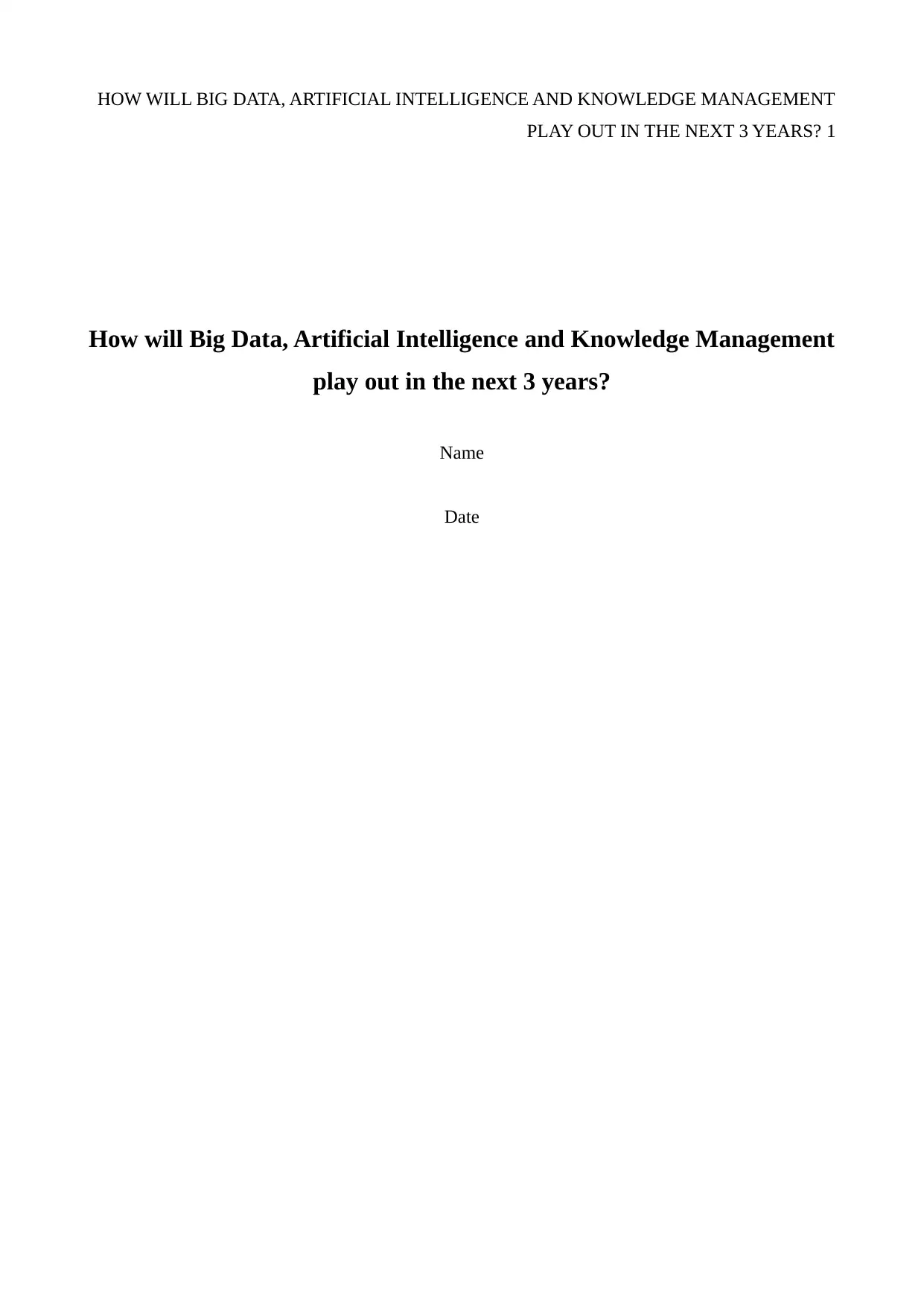
HOW WILL BIG DATA, ARTIFICIAL INTELLIGENCE AND KNOWLEDGE MANAGEMENT
PLAY OUT IN THE NEXT 3 YEARS? 1
How will Big Data, Artificial Intelligence and Knowledge Management
play out in the next 3 years?
Name
Date
PLAY OUT IN THE NEXT 3 YEARS? 1
How will Big Data, Artificial Intelligence and Knowledge Management
play out in the next 3 years?
Name
Date
Secure Best Marks with AI Grader
Need help grading? Try our AI Grader for instant feedback on your assignments.
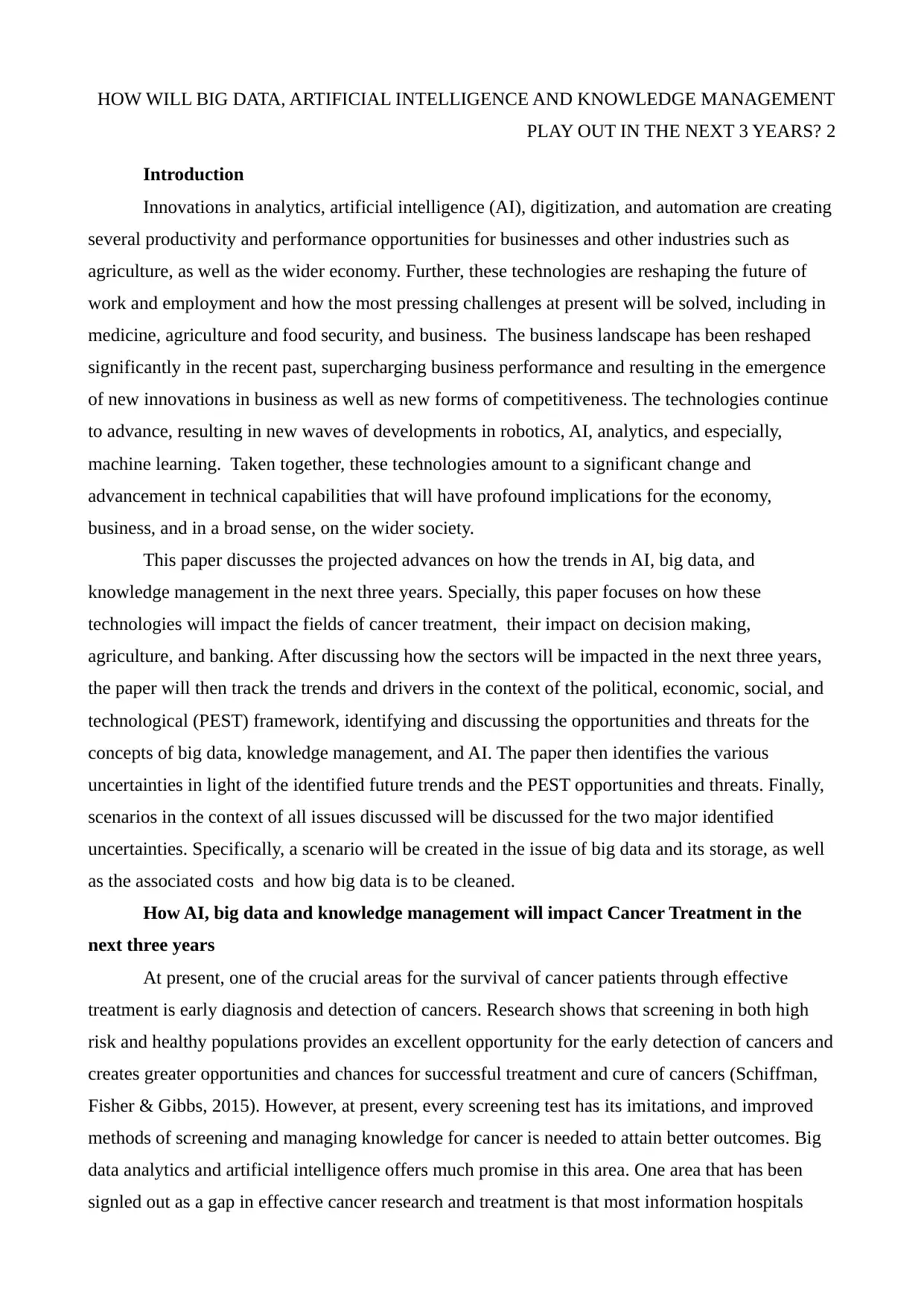
HOW WILL BIG DATA, ARTIFICIAL INTELLIGENCE AND KNOWLEDGE MANAGEMENT
PLAY OUT IN THE NEXT 3 YEARS? 2
Introduction
Innovations in analytics, artificial intelligence (AI), digitization, and automation are creating
several productivity and performance opportunities for businesses and other industries such as
agriculture, as well as the wider economy. Further, these technologies are reshaping the future of
work and employment and how the most pressing challenges at present will be solved, including in
medicine, agriculture and food security, and business. The business landscape has been reshaped
significantly in the recent past, supercharging business performance and resulting in the emergence
of new innovations in business as well as new forms of competitiveness. The technologies continue
to advance, resulting in new waves of developments in robotics, AI, analytics, and especially,
machine learning. Taken together, these technologies amount to a significant change and
advancement in technical capabilities that will have profound implications for the economy,
business, and in a broad sense, on the wider society.
This paper discusses the projected advances on how the trends in AI, big data, and
knowledge management in the next three years. Specially, this paper focuses on how these
technologies will impact the fields of cancer treatment, their impact on decision making,
agriculture, and banking. After discussing how the sectors will be impacted in the next three years,
the paper will then track the trends and drivers in the context of the political, economic, social, and
technological (PEST) framework, identifying and discussing the opportunities and threats for the
concepts of big data, knowledge management, and AI. The paper then identifies the various
uncertainties in light of the identified future trends and the PEST opportunities and threats. Finally,
scenarios in the context of all issues discussed will be discussed for the two major identified
uncertainties. Specifically, a scenario will be created in the issue of big data and its storage, as well
as the associated costs and how big data is to be cleaned.
How AI, big data and knowledge management will impact Cancer Treatment in the
next three years
At present, one of the crucial areas for the survival of cancer patients through effective
treatment is early diagnosis and detection of cancers. Research shows that screening in both high
risk and healthy populations provides an excellent opportunity for the early detection of cancers and
creates greater opportunities and chances for successful treatment and cure of cancers (Schiffman,
Fisher & Gibbs, 2015). However, at present, every screening test has its imitations, and improved
methods of screening and managing knowledge for cancer is needed to attain better outcomes. Big
data analytics and artificial intelligence offers much promise in this area. One area that has been
signled out as a gap in effective cancer research and treatment is that most information hospitals
PLAY OUT IN THE NEXT 3 YEARS? 2
Introduction
Innovations in analytics, artificial intelligence (AI), digitization, and automation are creating
several productivity and performance opportunities for businesses and other industries such as
agriculture, as well as the wider economy. Further, these technologies are reshaping the future of
work and employment and how the most pressing challenges at present will be solved, including in
medicine, agriculture and food security, and business. The business landscape has been reshaped
significantly in the recent past, supercharging business performance and resulting in the emergence
of new innovations in business as well as new forms of competitiveness. The technologies continue
to advance, resulting in new waves of developments in robotics, AI, analytics, and especially,
machine learning. Taken together, these technologies amount to a significant change and
advancement in technical capabilities that will have profound implications for the economy,
business, and in a broad sense, on the wider society.
This paper discusses the projected advances on how the trends in AI, big data, and
knowledge management in the next three years. Specially, this paper focuses on how these
technologies will impact the fields of cancer treatment, their impact on decision making,
agriculture, and banking. After discussing how the sectors will be impacted in the next three years,
the paper will then track the trends and drivers in the context of the political, economic, social, and
technological (PEST) framework, identifying and discussing the opportunities and threats for the
concepts of big data, knowledge management, and AI. The paper then identifies the various
uncertainties in light of the identified future trends and the PEST opportunities and threats. Finally,
scenarios in the context of all issues discussed will be discussed for the two major identified
uncertainties. Specifically, a scenario will be created in the issue of big data and its storage, as well
as the associated costs and how big data is to be cleaned.
How AI, big data and knowledge management will impact Cancer Treatment in the
next three years
At present, one of the crucial areas for the survival of cancer patients through effective
treatment is early diagnosis and detection of cancers. Research shows that screening in both high
risk and healthy populations provides an excellent opportunity for the early detection of cancers and
creates greater opportunities and chances for successful treatment and cure of cancers (Schiffman,
Fisher & Gibbs, 2015). However, at present, every screening test has its imitations, and improved
methods of screening and managing knowledge for cancer is needed to attain better outcomes. Big
data analytics and artificial intelligence offers much promise in this area. One area that has been
signled out as a gap in effective cancer research and treatment is that most information hospitals
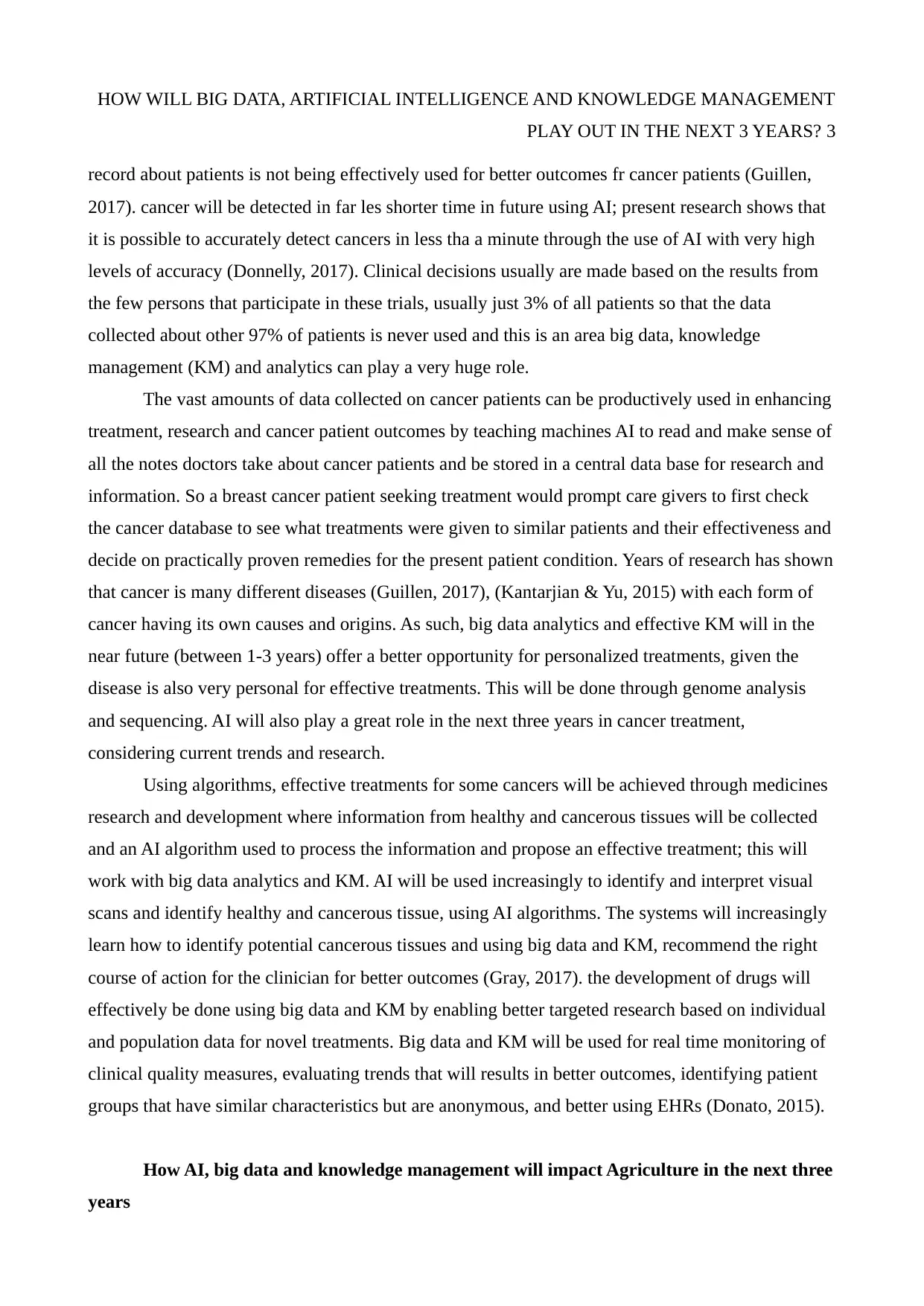
HOW WILL BIG DATA, ARTIFICIAL INTELLIGENCE AND KNOWLEDGE MANAGEMENT
PLAY OUT IN THE NEXT 3 YEARS? 3
record about patients is not being effectively used for better outcomes fr cancer patients (Guillen,
2017). cancer will be detected in far les shorter time in future using AI; present research shows that
it is possible to accurately detect cancers in less tha a minute through the use of AI with very high
levels of accuracy (Donnelly, 2017). Clinical decisions usually are made based on the results from
the few persons that participate in these trials, usually just 3% of all patients so that the data
collected about other 97% of patients is never used and this is an area big data, knowledge
management (KM) and analytics can play a very huge role.
The vast amounts of data collected on cancer patients can be productively used in enhancing
treatment, research and cancer patient outcomes by teaching machines AI to read and make sense of
all the notes doctors take about cancer patients and be stored in a central data base for research and
information. So a breast cancer patient seeking treatment would prompt care givers to first check
the cancer database to see what treatments were given to similar patients and their effectiveness and
decide on practically proven remedies for the present patient condition. Years of research has shown
that cancer is many different diseases (Guillen, 2017), (Kantarjian & Yu, 2015) with each form of
cancer having its own causes and origins. As such, big data analytics and effective KM will in the
near future (between 1-3 years) offer a better opportunity for personalized treatments, given the
disease is also very personal for effective treatments. This will be done through genome analysis
and sequencing. AI will also play a great role in the next three years in cancer treatment,
considering current trends and research.
Using algorithms, effective treatments for some cancers will be achieved through medicines
research and development where information from healthy and cancerous tissues will be collected
and an AI algorithm used to process the information and propose an effective treatment; this will
work with big data analytics and KM. AI will be used increasingly to identify and interpret visual
scans and identify healthy and cancerous tissue, using AI algorithms. The systems will increasingly
learn how to identify potential cancerous tissues and using big data and KM, recommend the right
course of action for the clinician for better outcomes (Gray, 2017). the development of drugs will
effectively be done using big data and KM by enabling better targeted research based on individual
and population data for novel treatments. Big data and KM will be used for real time monitoring of
clinical quality measures, evaluating trends that will results in better outcomes, identifying patient
groups that have similar characteristics but are anonymous, and better using EHRs (Donato, 2015).
How AI, big data and knowledge management will impact Agriculture in the next three
years
PLAY OUT IN THE NEXT 3 YEARS? 3
record about patients is not being effectively used for better outcomes fr cancer patients (Guillen,
2017). cancer will be detected in far les shorter time in future using AI; present research shows that
it is possible to accurately detect cancers in less tha a minute through the use of AI with very high
levels of accuracy (Donnelly, 2017). Clinical decisions usually are made based on the results from
the few persons that participate in these trials, usually just 3% of all patients so that the data
collected about other 97% of patients is never used and this is an area big data, knowledge
management (KM) and analytics can play a very huge role.
The vast amounts of data collected on cancer patients can be productively used in enhancing
treatment, research and cancer patient outcomes by teaching machines AI to read and make sense of
all the notes doctors take about cancer patients and be stored in a central data base for research and
information. So a breast cancer patient seeking treatment would prompt care givers to first check
the cancer database to see what treatments were given to similar patients and their effectiveness and
decide on practically proven remedies for the present patient condition. Years of research has shown
that cancer is many different diseases (Guillen, 2017), (Kantarjian & Yu, 2015) with each form of
cancer having its own causes and origins. As such, big data analytics and effective KM will in the
near future (between 1-3 years) offer a better opportunity for personalized treatments, given the
disease is also very personal for effective treatments. This will be done through genome analysis
and sequencing. AI will also play a great role in the next three years in cancer treatment,
considering current trends and research.
Using algorithms, effective treatments for some cancers will be achieved through medicines
research and development where information from healthy and cancerous tissues will be collected
and an AI algorithm used to process the information and propose an effective treatment; this will
work with big data analytics and KM. AI will be used increasingly to identify and interpret visual
scans and identify healthy and cancerous tissue, using AI algorithms. The systems will increasingly
learn how to identify potential cancerous tissues and using big data and KM, recommend the right
course of action for the clinician for better outcomes (Gray, 2017). the development of drugs will
effectively be done using big data and KM by enabling better targeted research based on individual
and population data for novel treatments. Big data and KM will be used for real time monitoring of
clinical quality measures, evaluating trends that will results in better outcomes, identifying patient
groups that have similar characteristics but are anonymous, and better using EHRs (Donato, 2015).
How AI, big data and knowledge management will impact Agriculture in the next three
years
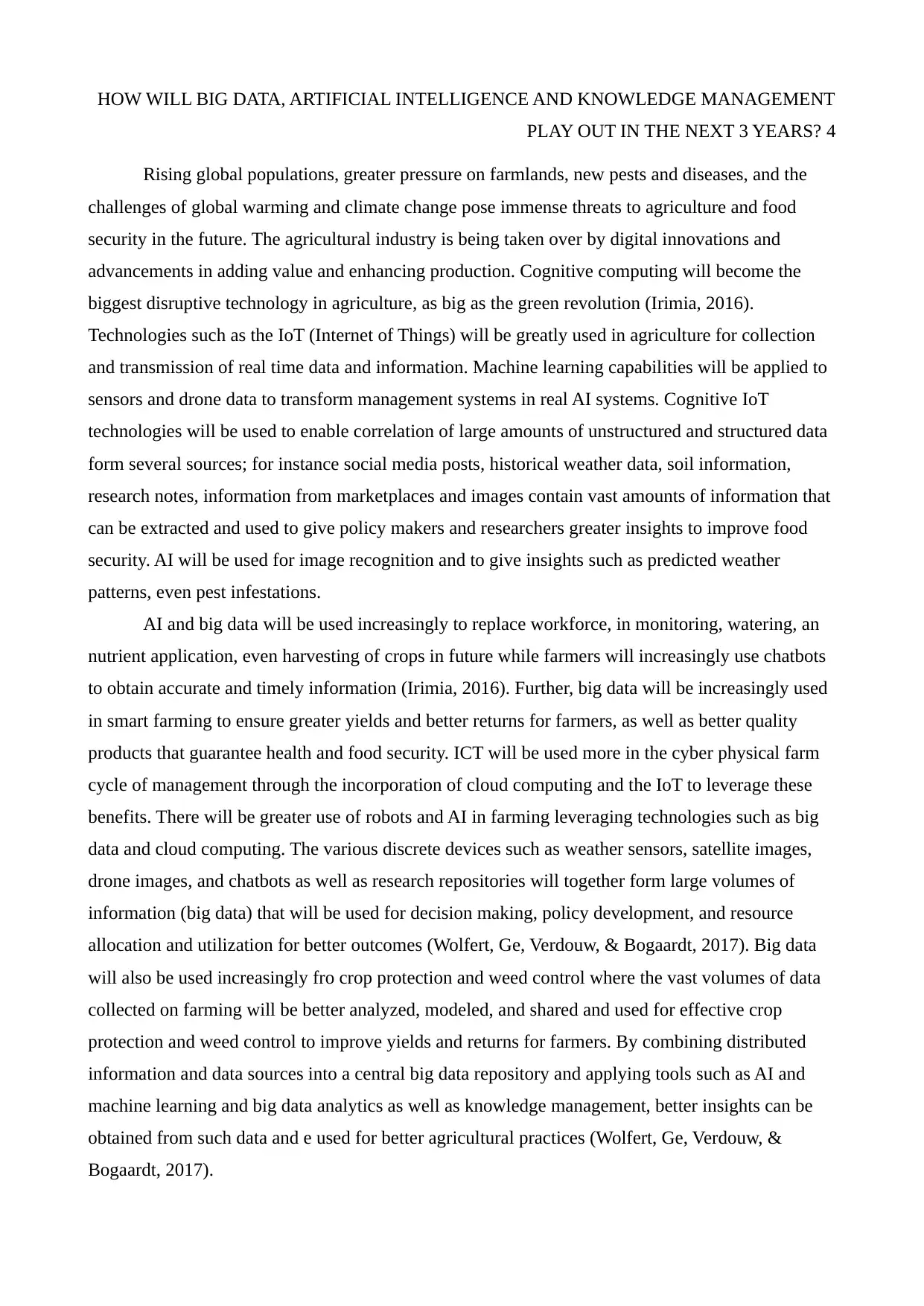
HOW WILL BIG DATA, ARTIFICIAL INTELLIGENCE AND KNOWLEDGE MANAGEMENT
PLAY OUT IN THE NEXT 3 YEARS? 4
Rising global populations, greater pressure on farmlands, new pests and diseases, and the
challenges of global warming and climate change pose immense threats to agriculture and food
security in the future. The agricultural industry is being taken over by digital innovations and
advancements in adding value and enhancing production. Cognitive computing will become the
biggest disruptive technology in agriculture, as big as the green revolution (Irimia, 2016).
Technologies such as the IoT (Internet of Things) will be greatly used in agriculture for collection
and transmission of real time data and information. Machine learning capabilities will be applied to
sensors and drone data to transform management systems in real AI systems. Cognitive IoT
technologies will be used to enable correlation of large amounts of unstructured and structured data
form several sources; for instance social media posts, historical weather data, soil information,
research notes, information from marketplaces and images contain vast amounts of information that
can be extracted and used to give policy makers and researchers greater insights to improve food
security. AI will be used for image recognition and to give insights such as predicted weather
patterns, even pest infestations.
AI and big data will be used increasingly to replace workforce, in monitoring, watering, an
nutrient application, even harvesting of crops in future while farmers will increasingly use chatbots
to obtain accurate and timely information (Irimia, 2016). Further, big data will be increasingly used
in smart farming to ensure greater yields and better returns for farmers, as well as better quality
products that guarantee health and food security. ICT will be used more in the cyber physical farm
cycle of management through the incorporation of cloud computing and the IoT to leverage these
benefits. There will be greater use of robots and AI in farming leveraging technologies such as big
data and cloud computing. The various discrete devices such as weather sensors, satellite images,
drone images, and chatbots as well as research repositories will together form large volumes of
information (big data) that will be used for decision making, policy development, and resource
allocation and utilization for better outcomes (Wolfert, Ge, Verdouw, & Bogaardt, 2017). Big data
will also be used increasingly fro crop protection and weed control where the vast volumes of data
collected on farming will be better analyzed, modeled, and shared and used for effective crop
protection and weed control to improve yields and returns for farmers. By combining distributed
information and data sources into a central big data repository and applying tools such as AI and
machine learning and big data analytics as well as knowledge management, better insights can be
obtained from such data and e used for better agricultural practices (Wolfert, Ge, Verdouw, &
Bogaardt, 2017).
PLAY OUT IN THE NEXT 3 YEARS? 4
Rising global populations, greater pressure on farmlands, new pests and diseases, and the
challenges of global warming and climate change pose immense threats to agriculture and food
security in the future. The agricultural industry is being taken over by digital innovations and
advancements in adding value and enhancing production. Cognitive computing will become the
biggest disruptive technology in agriculture, as big as the green revolution (Irimia, 2016).
Technologies such as the IoT (Internet of Things) will be greatly used in agriculture for collection
and transmission of real time data and information. Machine learning capabilities will be applied to
sensors and drone data to transform management systems in real AI systems. Cognitive IoT
technologies will be used to enable correlation of large amounts of unstructured and structured data
form several sources; for instance social media posts, historical weather data, soil information,
research notes, information from marketplaces and images contain vast amounts of information that
can be extracted and used to give policy makers and researchers greater insights to improve food
security. AI will be used for image recognition and to give insights such as predicted weather
patterns, even pest infestations.
AI and big data will be used increasingly to replace workforce, in monitoring, watering, an
nutrient application, even harvesting of crops in future while farmers will increasingly use chatbots
to obtain accurate and timely information (Irimia, 2016). Further, big data will be increasingly used
in smart farming to ensure greater yields and better returns for farmers, as well as better quality
products that guarantee health and food security. ICT will be used more in the cyber physical farm
cycle of management through the incorporation of cloud computing and the IoT to leverage these
benefits. There will be greater use of robots and AI in farming leveraging technologies such as big
data and cloud computing. The various discrete devices such as weather sensors, satellite images,
drone images, and chatbots as well as research repositories will together form large volumes of
information (big data) that will be used for decision making, policy development, and resource
allocation and utilization for better outcomes (Wolfert, Ge, Verdouw, & Bogaardt, 2017). Big data
will also be used increasingly fro crop protection and weed control where the vast volumes of data
collected on farming will be better analyzed, modeled, and shared and used for effective crop
protection and weed control to improve yields and returns for farmers. By combining distributed
information and data sources into a central big data repository and applying tools such as AI and
machine learning and big data analytics as well as knowledge management, better insights can be
obtained from such data and e used for better agricultural practices (Wolfert, Ge, Verdouw, &
Bogaardt, 2017).
Secure Best Marks with AI Grader
Need help grading? Try our AI Grader for instant feedback on your assignments.
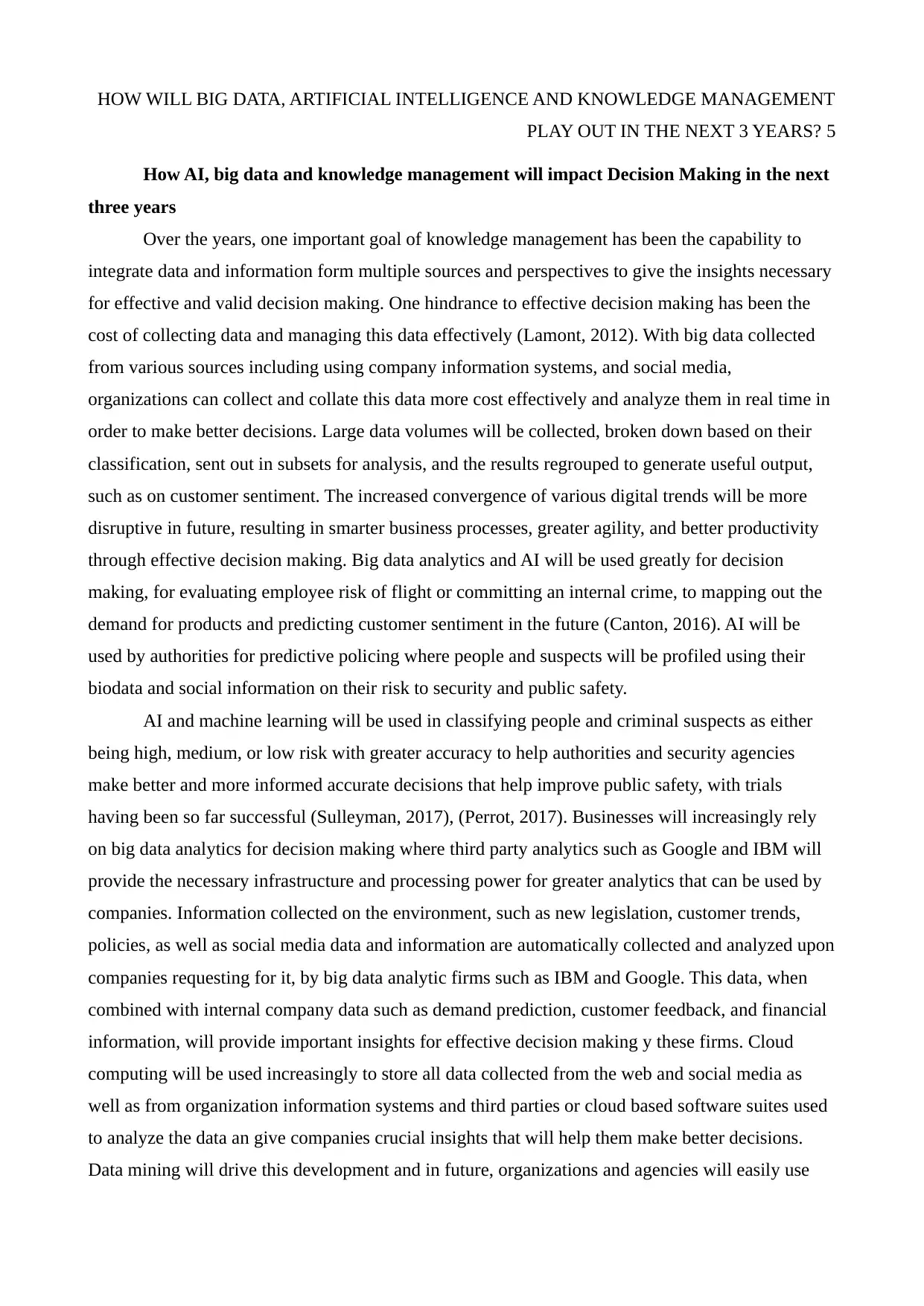
HOW WILL BIG DATA, ARTIFICIAL INTELLIGENCE AND KNOWLEDGE MANAGEMENT
PLAY OUT IN THE NEXT 3 YEARS? 5
How AI, big data and knowledge management will impact Decision Making in the next
three years
Over the years, one important goal of knowledge management has been the capability to
integrate data and information form multiple sources and perspectives to give the insights necessary
for effective and valid decision making. One hindrance to effective decision making has been the
cost of collecting data and managing this data effectively (Lamont, 2012). With big data collected
from various sources including using company information systems, and social media,
organizations can collect and collate this data more cost effectively and analyze them in real time in
order to make better decisions. Large data volumes will be collected, broken down based on their
classification, sent out in subsets for analysis, and the results regrouped to generate useful output,
such as on customer sentiment. The increased convergence of various digital trends will be more
disruptive in future, resulting in smarter business processes, greater agility, and better productivity
through effective decision making. Big data analytics and AI will be used greatly for decision
making, for evaluating employee risk of flight or committing an internal crime, to mapping out the
demand for products and predicting customer sentiment in the future (Canton, 2016). AI will be
used by authorities for predictive policing where people and suspects will be profiled using their
biodata and social information on their risk to security and public safety.
AI and machine learning will be used in classifying people and criminal suspects as either
being high, medium, or low risk with greater accuracy to help authorities and security agencies
make better and more informed accurate decisions that help improve public safety, with trials
having been so far successful (Sulleyman, 2017), (Perrot, 2017). Businesses will increasingly rely
on big data analytics for decision making where third party analytics such as Google and IBM will
provide the necessary infrastructure and processing power for greater analytics that can be used by
companies. Information collected on the environment, such as new legislation, customer trends,
policies, as well as social media data and information are automatically collected and analyzed upon
companies requesting for it, by big data analytic firms such as IBM and Google. This data, when
combined with internal company data such as demand prediction, customer feedback, and financial
information, will provide important insights for effective decision making y these firms. Cloud
computing will be used increasingly to store all data collected from the web and social media as
well as from organization information systems and third parties or cloud based software suites used
to analyze the data an give companies crucial insights that will help them make better decisions.
Data mining will drive this development and in future, organizations and agencies will easily use
PLAY OUT IN THE NEXT 3 YEARS? 5
How AI, big data and knowledge management will impact Decision Making in the next
three years
Over the years, one important goal of knowledge management has been the capability to
integrate data and information form multiple sources and perspectives to give the insights necessary
for effective and valid decision making. One hindrance to effective decision making has been the
cost of collecting data and managing this data effectively (Lamont, 2012). With big data collected
from various sources including using company information systems, and social media,
organizations can collect and collate this data more cost effectively and analyze them in real time in
order to make better decisions. Large data volumes will be collected, broken down based on their
classification, sent out in subsets for analysis, and the results regrouped to generate useful output,
such as on customer sentiment. The increased convergence of various digital trends will be more
disruptive in future, resulting in smarter business processes, greater agility, and better productivity
through effective decision making. Big data analytics and AI will be used greatly for decision
making, for evaluating employee risk of flight or committing an internal crime, to mapping out the
demand for products and predicting customer sentiment in the future (Canton, 2016). AI will be
used by authorities for predictive policing where people and suspects will be profiled using their
biodata and social information on their risk to security and public safety.
AI and machine learning will be used in classifying people and criminal suspects as either
being high, medium, or low risk with greater accuracy to help authorities and security agencies
make better and more informed accurate decisions that help improve public safety, with trials
having been so far successful (Sulleyman, 2017), (Perrot, 2017). Businesses will increasingly rely
on big data analytics for decision making where third party analytics such as Google and IBM will
provide the necessary infrastructure and processing power for greater analytics that can be used by
companies. Information collected on the environment, such as new legislation, customer trends,
policies, as well as social media data and information are automatically collected and analyzed upon
companies requesting for it, by big data analytic firms such as IBM and Google. This data, when
combined with internal company data such as demand prediction, customer feedback, and financial
information, will provide important insights for effective decision making y these firms. Cloud
computing will be used increasingly to store all data collected from the web and social media as
well as from organization information systems and third parties or cloud based software suites used
to analyze the data an give companies crucial insights that will help them make better decisions.
Data mining will drive this development and in future, organizations and agencies will easily use
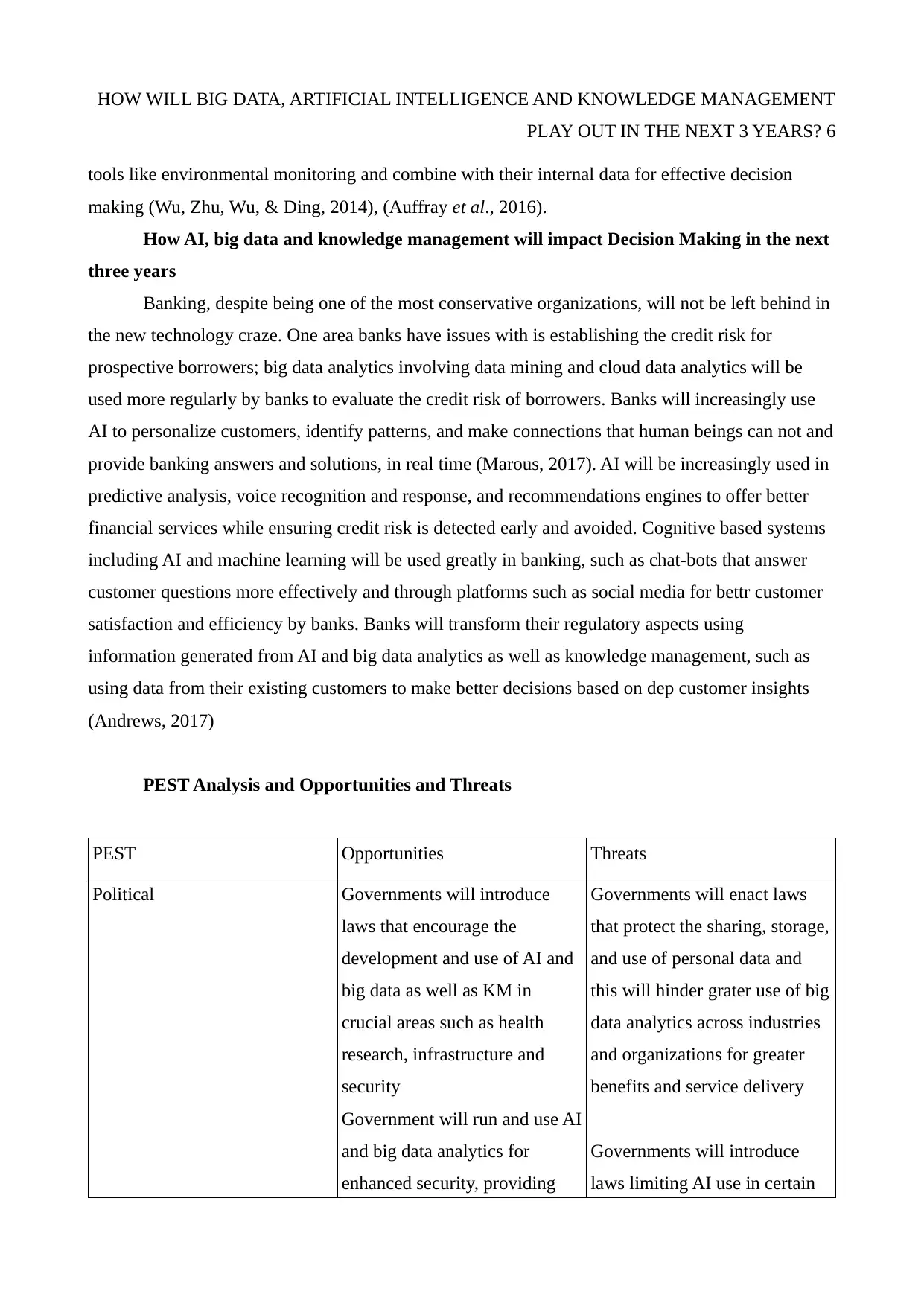
HOW WILL BIG DATA, ARTIFICIAL INTELLIGENCE AND KNOWLEDGE MANAGEMENT
PLAY OUT IN THE NEXT 3 YEARS? 6
tools like environmental monitoring and combine with their internal data for effective decision
making (Wu, Zhu, Wu, & Ding, 2014), (Auffray et al., 2016).
How AI, big data and knowledge management will impact Decision Making in the next
three years
Banking, despite being one of the most conservative organizations, will not be left behind in
the new technology craze. One area banks have issues with is establishing the credit risk for
prospective borrowers; big data analytics involving data mining and cloud data analytics will be
used more regularly by banks to evaluate the credit risk of borrowers. Banks will increasingly use
AI to personalize customers, identify patterns, and make connections that human beings can not and
provide banking answers and solutions, in real time (Marous, 2017). AI will be increasingly used in
predictive analysis, voice recognition and response, and recommendations engines to offer better
financial services while ensuring credit risk is detected early and avoided. Cognitive based systems
including AI and machine learning will be used greatly in banking, such as chat-bots that answer
customer questions more effectively and through platforms such as social media for bettr customer
satisfaction and efficiency by banks. Banks will transform their regulatory aspects using
information generated from AI and big data analytics as well as knowledge management, such as
using data from their existing customers to make better decisions based on dep customer insights
(Andrews, 2017)
PEST Analysis and Opportunities and Threats
PEST Opportunities Threats
Political Governments will introduce
laws that encourage the
development and use of AI and
big data as well as KM in
crucial areas such as health
research, infrastructure and
security
Government will run and use AI
and big data analytics for
enhanced security, providing
Governments will enact laws
that protect the sharing, storage,
and use of personal data and
this will hinder grater use of big
data analytics across industries
and organizations for greater
benefits and service delivery
Governments will introduce
laws limiting AI use in certain
PLAY OUT IN THE NEXT 3 YEARS? 6
tools like environmental monitoring and combine with their internal data for effective decision
making (Wu, Zhu, Wu, & Ding, 2014), (Auffray et al., 2016).
How AI, big data and knowledge management will impact Decision Making in the next
three years
Banking, despite being one of the most conservative organizations, will not be left behind in
the new technology craze. One area banks have issues with is establishing the credit risk for
prospective borrowers; big data analytics involving data mining and cloud data analytics will be
used more regularly by banks to evaluate the credit risk of borrowers. Banks will increasingly use
AI to personalize customers, identify patterns, and make connections that human beings can not and
provide banking answers and solutions, in real time (Marous, 2017). AI will be increasingly used in
predictive analysis, voice recognition and response, and recommendations engines to offer better
financial services while ensuring credit risk is detected early and avoided. Cognitive based systems
including AI and machine learning will be used greatly in banking, such as chat-bots that answer
customer questions more effectively and through platforms such as social media for bettr customer
satisfaction and efficiency by banks. Banks will transform their regulatory aspects using
information generated from AI and big data analytics as well as knowledge management, such as
using data from their existing customers to make better decisions based on dep customer insights
(Andrews, 2017)
PEST Analysis and Opportunities and Threats
PEST Opportunities Threats
Political Governments will introduce
laws that encourage the
development and use of AI and
big data as well as KM in
crucial areas such as health
research, infrastructure and
security
Government will run and use AI
and big data analytics for
enhanced security, providing
Governments will enact laws
that protect the sharing, storage,
and use of personal data and
this will hinder grater use of big
data analytics across industries
and organizations for greater
benefits and service delivery
Governments will introduce
laws limiting AI use in certain
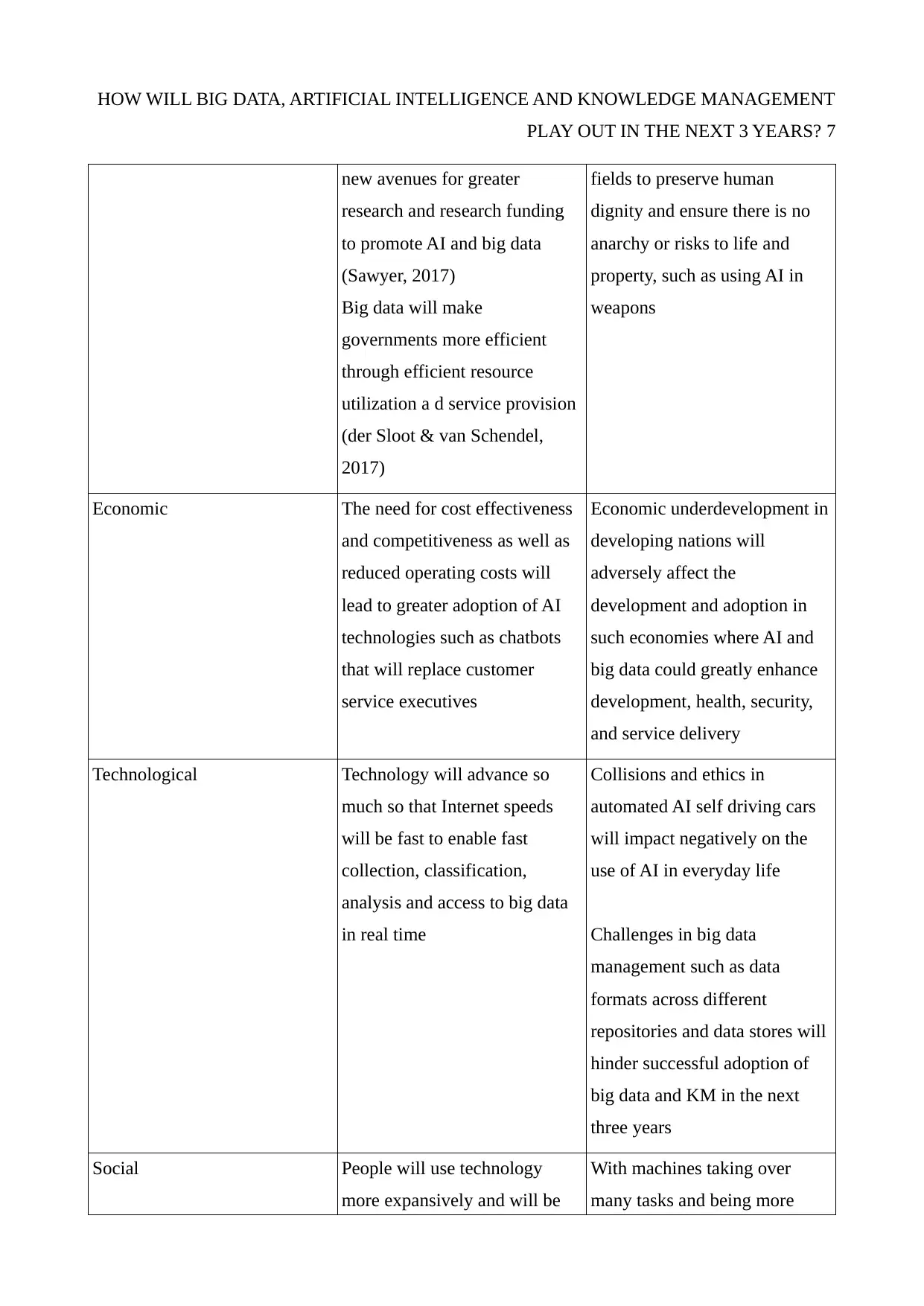
HOW WILL BIG DATA, ARTIFICIAL INTELLIGENCE AND KNOWLEDGE MANAGEMENT
PLAY OUT IN THE NEXT 3 YEARS? 7
new avenues for greater
research and research funding
to promote AI and big data
(Sawyer, 2017)
Big data will make
governments more efficient
through efficient resource
utilization a d service provision
(der Sloot & van Schendel,
2017)
fields to preserve human
dignity and ensure there is no
anarchy or risks to life and
property, such as using AI in
weapons
Economic The need for cost effectiveness
and competitiveness as well as
reduced operating costs will
lead to greater adoption of AI
technologies such as chatbots
that will replace customer
service executives
Economic underdevelopment in
developing nations will
adversely affect the
development and adoption in
such economies where AI and
big data could greatly enhance
development, health, security,
and service delivery
Technological Technology will advance so
much so that Internet speeds
will be fast to enable fast
collection, classification,
analysis and access to big data
in real time
Collisions and ethics in
automated AI self driving cars
will impact negatively on the
use of AI in everyday life
Challenges in big data
management such as data
formats across different
repositories and data stores will
hinder successful adoption of
big data and KM in the next
three years
Social People will use technology
more expansively and will be
With machines taking over
many tasks and being more
PLAY OUT IN THE NEXT 3 YEARS? 7
new avenues for greater
research and research funding
to promote AI and big data
(Sawyer, 2017)
Big data will make
governments more efficient
through efficient resource
utilization a d service provision
(der Sloot & van Schendel,
2017)
fields to preserve human
dignity and ensure there is no
anarchy or risks to life and
property, such as using AI in
weapons
Economic The need for cost effectiveness
and competitiveness as well as
reduced operating costs will
lead to greater adoption of AI
technologies such as chatbots
that will replace customer
service executives
Economic underdevelopment in
developing nations will
adversely affect the
development and adoption in
such economies where AI and
big data could greatly enhance
development, health, security,
and service delivery
Technological Technology will advance so
much so that Internet speeds
will be fast to enable fast
collection, classification,
analysis and access to big data
in real time
Collisions and ethics in
automated AI self driving cars
will impact negatively on the
use of AI in everyday life
Challenges in big data
management such as data
formats across different
repositories and data stores will
hinder successful adoption of
big data and KM in the next
three years
Social People will use technology
more expansively and will be
With machines taking over
many tasks and being more
Paraphrase This Document
Need a fresh take? Get an instant paraphrase of this document with our AI Paraphraser
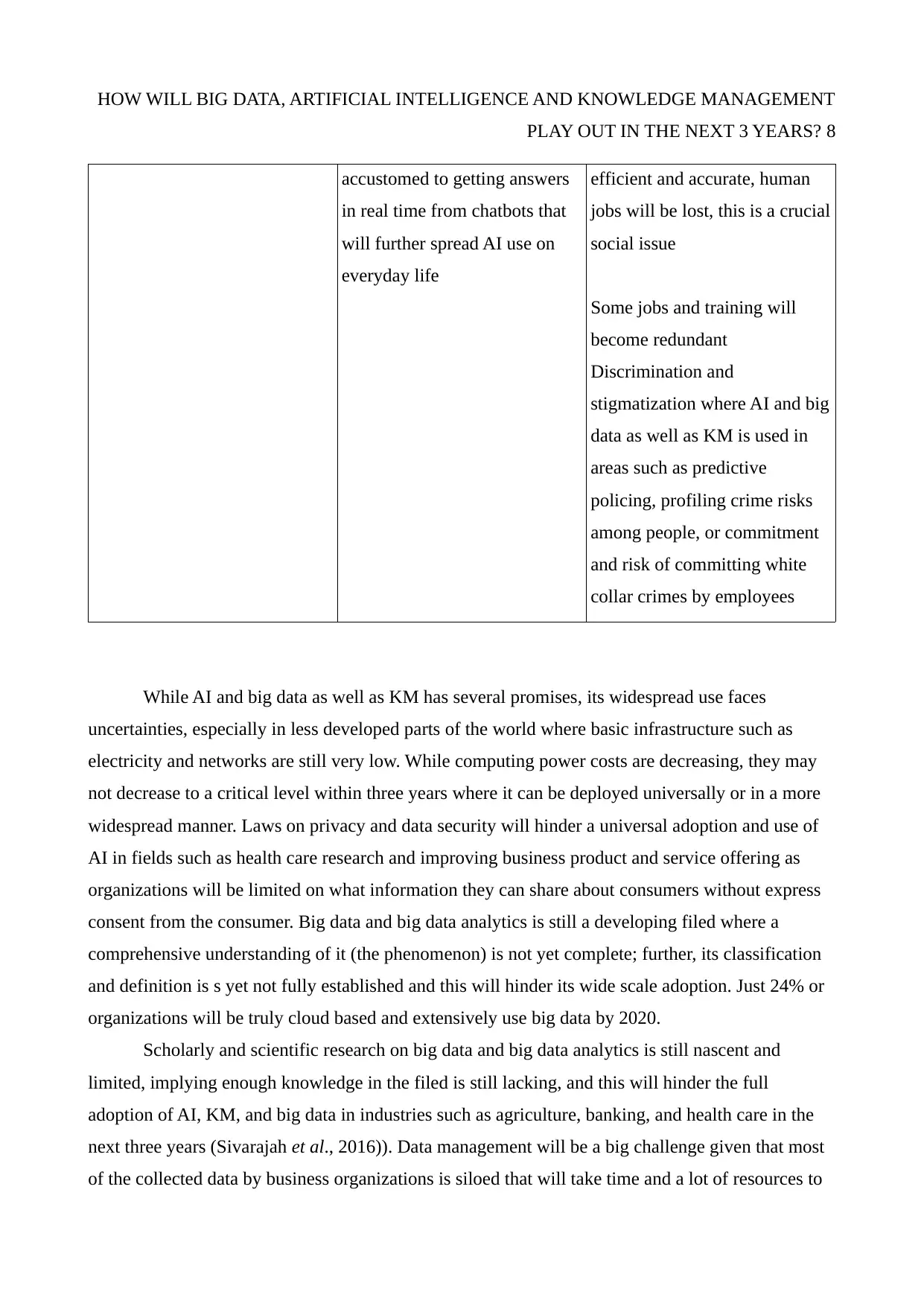
HOW WILL BIG DATA, ARTIFICIAL INTELLIGENCE AND KNOWLEDGE MANAGEMENT
PLAY OUT IN THE NEXT 3 YEARS? 8
accustomed to getting answers
in real time from chatbots that
will further spread AI use on
everyday life
efficient and accurate, human
jobs will be lost, this is a crucial
social issue
Some jobs and training will
become redundant
Discrimination and
stigmatization where AI and big
data as well as KM is used in
areas such as predictive
policing, profiling crime risks
among people, or commitment
and risk of committing white
collar crimes by employees
While AI and big data as well as KM has several promises, its widespread use faces
uncertainties, especially in less developed parts of the world where basic infrastructure such as
electricity and networks are still very low. While computing power costs are decreasing, they may
not decrease to a critical level within three years where it can be deployed universally or in a more
widespread manner. Laws on privacy and data security will hinder a universal adoption and use of
AI in fields such as health care research and improving business product and service offering as
organizations will be limited on what information they can share about consumers without express
consent from the consumer. Big data and big data analytics is still a developing filed where a
comprehensive understanding of it (the phenomenon) is not yet complete; further, its classification
and definition is s yet not fully established and this will hinder its wide scale adoption. Just 24% or
organizations will be truly cloud based and extensively use big data by 2020.
Scholarly and scientific research on big data and big data analytics is still nascent and
limited, implying enough knowledge in the filed is still lacking, and this will hinder the full
adoption of AI, KM, and big data in industries such as agriculture, banking, and health care in the
next three years (Sivarajah et al., 2016)). Data management will be a big challenge given that most
of the collected data by business organizations is siloed that will take time and a lot of resources to
PLAY OUT IN THE NEXT 3 YEARS? 8
accustomed to getting answers
in real time from chatbots that
will further spread AI use on
everyday life
efficient and accurate, human
jobs will be lost, this is a crucial
social issue
Some jobs and training will
become redundant
Discrimination and
stigmatization where AI and big
data as well as KM is used in
areas such as predictive
policing, profiling crime risks
among people, or commitment
and risk of committing white
collar crimes by employees
While AI and big data as well as KM has several promises, its widespread use faces
uncertainties, especially in less developed parts of the world where basic infrastructure such as
electricity and networks are still very low. While computing power costs are decreasing, they may
not decrease to a critical level within three years where it can be deployed universally or in a more
widespread manner. Laws on privacy and data security will hinder a universal adoption and use of
AI in fields such as health care research and improving business product and service offering as
organizations will be limited on what information they can share about consumers without express
consent from the consumer. Big data and big data analytics is still a developing filed where a
comprehensive understanding of it (the phenomenon) is not yet complete; further, its classification
and definition is s yet not fully established and this will hinder its wide scale adoption. Just 24% or
organizations will be truly cloud based and extensively use big data by 2020.
Scholarly and scientific research on big data and big data analytics is still nascent and
limited, implying enough knowledge in the filed is still lacking, and this will hinder the full
adoption of AI, KM, and big data in industries such as agriculture, banking, and health care in the
next three years (Sivarajah et al., 2016)). Data management will be a big challenge given that most
of the collected data by business organizations is siloed that will take time and a lot of resources to
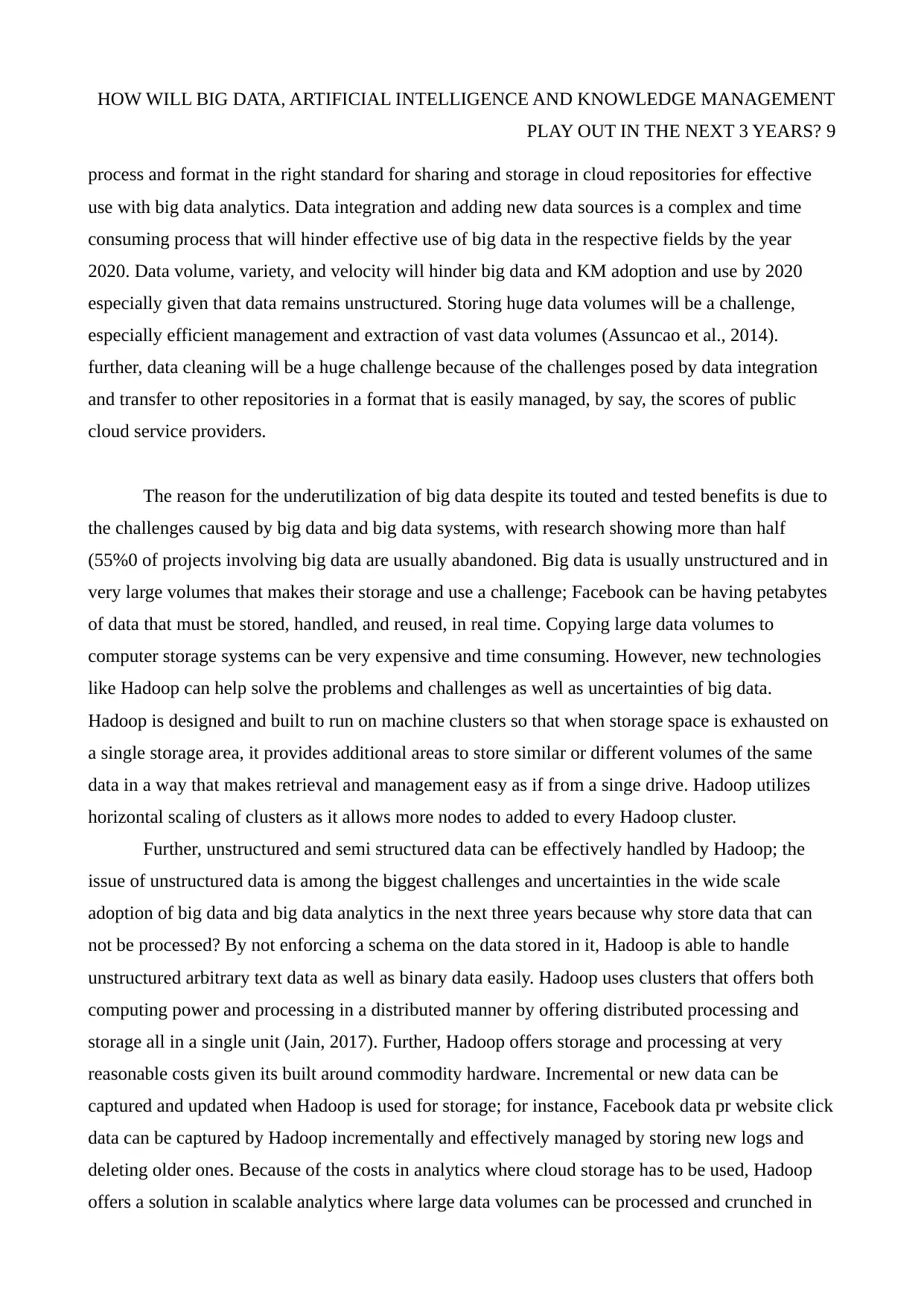
HOW WILL BIG DATA, ARTIFICIAL INTELLIGENCE AND KNOWLEDGE MANAGEMENT
PLAY OUT IN THE NEXT 3 YEARS? 9
process and format in the right standard for sharing and storage in cloud repositories for effective
use with big data analytics. Data integration and adding new data sources is a complex and time
consuming process that will hinder effective use of big data in the respective fields by the year
2020. Data volume, variety, and velocity will hinder big data and KM adoption and use by 2020
especially given that data remains unstructured. Storing huge data volumes will be a challenge,
especially efficient management and extraction of vast data volumes (Assuncao et al., 2014).
further, data cleaning will be a huge challenge because of the challenges posed by data integration
and transfer to other repositories in a format that is easily managed, by say, the scores of public
cloud service providers.
The reason for the underutilization of big data despite its touted and tested benefits is due to
the challenges caused by big data and big data systems, with research showing more than half
(55%0 of projects involving big data are usually abandoned. Big data is usually unstructured and in
very large volumes that makes their storage and use a challenge; Facebook can be having petabytes
of data that must be stored, handled, and reused, in real time. Copying large data volumes to
computer storage systems can be very expensive and time consuming. However, new technologies
like Hadoop can help solve the problems and challenges as well as uncertainties of big data.
Hadoop is designed and built to run on machine clusters so that when storage space is exhausted on
a single storage area, it provides additional areas to store similar or different volumes of the same
data in a way that makes retrieval and management easy as if from a singe drive. Hadoop utilizes
horizontal scaling of clusters as it allows more nodes to added to every Hadoop cluster.
Further, unstructured and semi structured data can be effectively handled by Hadoop; the
issue of unstructured data is among the biggest challenges and uncertainties in the wide scale
adoption of big data and big data analytics in the next three years because why store data that can
not be processed? By not enforcing a schema on the data stored in it, Hadoop is able to handle
unstructured arbitrary text data as well as binary data easily. Hadoop uses clusters that offers both
computing power and processing in a distributed manner by offering distributed processing and
storage all in a single unit (Jain, 2017). Further, Hadoop offers storage and processing at very
reasonable costs given its built around commodity hardware. Incremental or new data can be
captured and updated when Hadoop is used for storage; for instance, Facebook data pr website click
data can be captured by Hadoop incrementally and effectively managed by storing new logs and
deleting older ones. Because of the costs in analytics where cloud storage has to be used, Hadoop
offers a solution in scalable analytics where large data volumes can be processed and crunched in
PLAY OUT IN THE NEXT 3 YEARS? 9
process and format in the right standard for sharing and storage in cloud repositories for effective
use with big data analytics. Data integration and adding new data sources is a complex and time
consuming process that will hinder effective use of big data in the respective fields by the year
2020. Data volume, variety, and velocity will hinder big data and KM adoption and use by 2020
especially given that data remains unstructured. Storing huge data volumes will be a challenge,
especially efficient management and extraction of vast data volumes (Assuncao et al., 2014).
further, data cleaning will be a huge challenge because of the challenges posed by data integration
and transfer to other repositories in a format that is easily managed, by say, the scores of public
cloud service providers.
The reason for the underutilization of big data despite its touted and tested benefits is due to
the challenges caused by big data and big data systems, with research showing more than half
(55%0 of projects involving big data are usually abandoned. Big data is usually unstructured and in
very large volumes that makes their storage and use a challenge; Facebook can be having petabytes
of data that must be stored, handled, and reused, in real time. Copying large data volumes to
computer storage systems can be very expensive and time consuming. However, new technologies
like Hadoop can help solve the problems and challenges as well as uncertainties of big data.
Hadoop is designed and built to run on machine clusters so that when storage space is exhausted on
a single storage area, it provides additional areas to store similar or different volumes of the same
data in a way that makes retrieval and management easy as if from a singe drive. Hadoop utilizes
horizontal scaling of clusters as it allows more nodes to added to every Hadoop cluster.
Further, unstructured and semi structured data can be effectively handled by Hadoop; the
issue of unstructured data is among the biggest challenges and uncertainties in the wide scale
adoption of big data and big data analytics in the next three years because why store data that can
not be processed? By not enforcing a schema on the data stored in it, Hadoop is able to handle
unstructured arbitrary text data as well as binary data easily. Hadoop uses clusters that offers both
computing power and processing in a distributed manner by offering distributed processing and
storage all in a single unit (Jain, 2017). Further, Hadoop offers storage and processing at very
reasonable costs given its built around commodity hardware. Incremental or new data can be
captured and updated when Hadoop is used for storage; for instance, Facebook data pr website click
data can be captured by Hadoop incrementally and effectively managed by storing new logs and
deleting older ones. Because of the costs in analytics where cloud storage has to be used, Hadoop
offers a solution in scalable analytics where large data volumes can be processed and crunched in
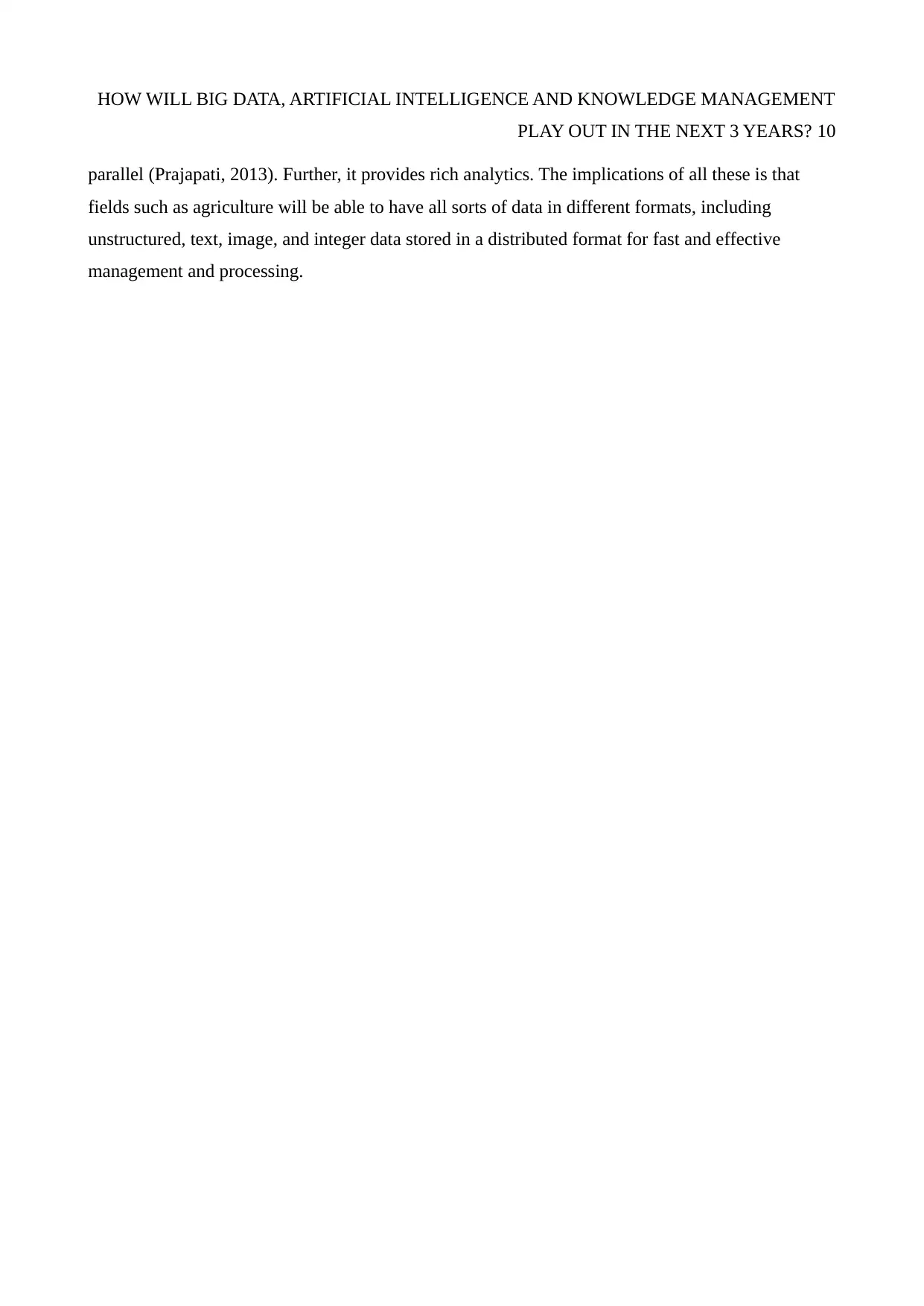
HOW WILL BIG DATA, ARTIFICIAL INTELLIGENCE AND KNOWLEDGE MANAGEMENT
PLAY OUT IN THE NEXT 3 YEARS? 10
parallel (Prajapati, 2013). Further, it provides rich analytics. The implications of all these is that
fields such as agriculture will be able to have all sorts of data in different formats, including
unstructured, text, image, and integer data stored in a distributed format for fast and effective
management and processing.
PLAY OUT IN THE NEXT 3 YEARS? 10
parallel (Prajapati, 2013). Further, it provides rich analytics. The implications of all these is that
fields such as agriculture will be able to have all sorts of data in different formats, including
unstructured, text, image, and integer data stored in a distributed format for fast and effective
management and processing.
Secure Best Marks with AI Grader
Need help grading? Try our AI Grader for instant feedback on your assignments.
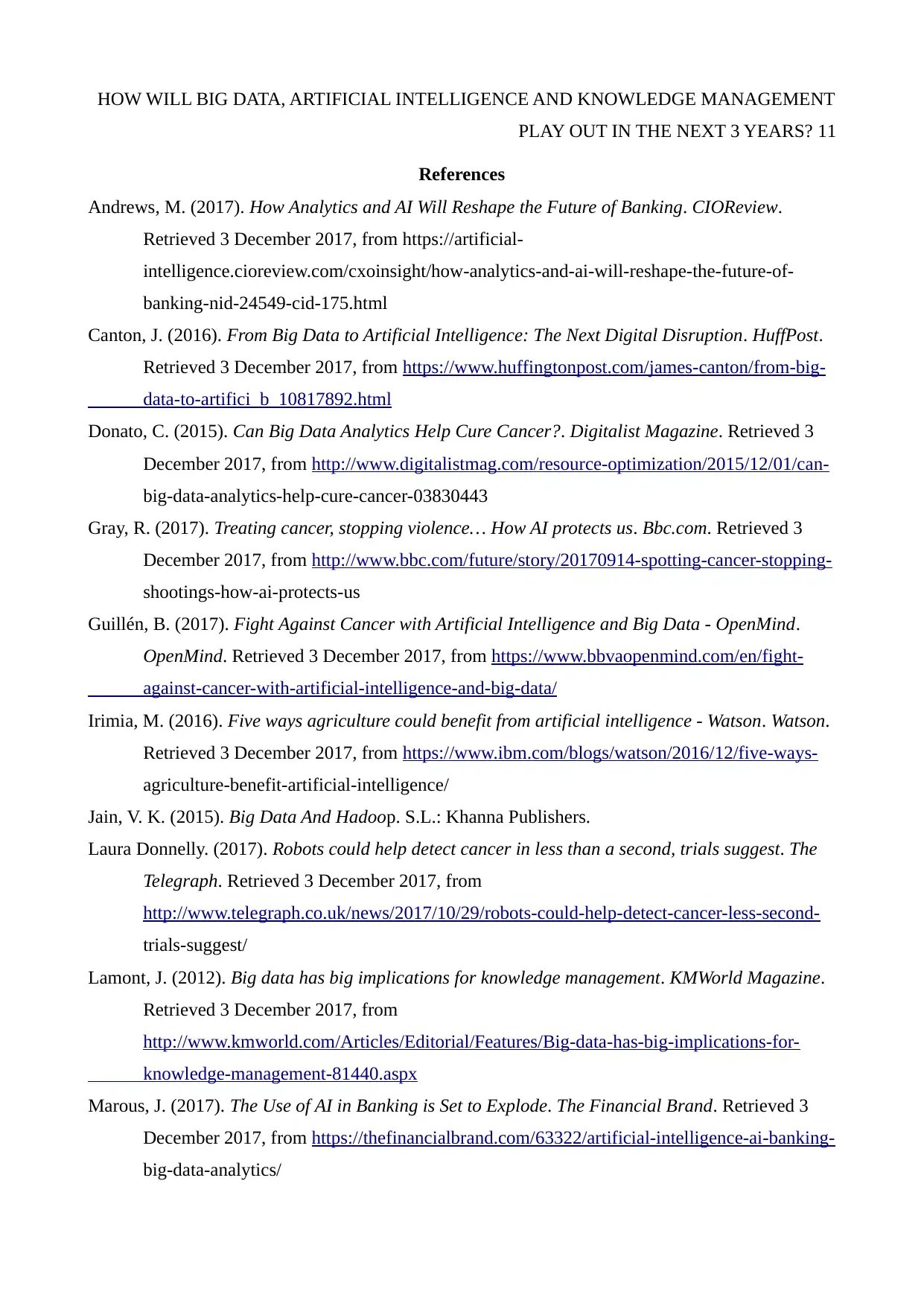
HOW WILL BIG DATA, ARTIFICIAL INTELLIGENCE AND KNOWLEDGE MANAGEMENT
PLAY OUT IN THE NEXT 3 YEARS? 11
References
Andrews, M. (2017). How Analytics and AI Will Reshape the Future of Banking. CIOReview.
Retrieved 3 December 2017, from https://artificial-
intelligence.cioreview.com/cxoinsight/how-analytics-and-ai-will-reshape-the-future-of-
banking-nid-24549-cid-175.html
Canton, J. (2016). From Big Data to Artificial Intelligence: The Next Digital Disruption. HuffPost.
Retrieved 3 December 2017, from https://www.huffingtonpost.com/james-canton/from-big-
data-to-artifici_b_10817892.html
Donato, C. (2015). Can Big Data Analytics Help Cure Cancer?. Digitalist Magazine. Retrieved 3
December 2017, from http://www.digitalistmag.com/resource-optimization/2015/12/01/can-
big-data-analytics-help-cure-cancer-03830443
Gray, R. (2017). Treating cancer, stopping violence… How AI protects us. Bbc.com. Retrieved 3
December 2017, from http://www.bbc.com/future/story/20170914-spotting-cancer-stopping-
shootings-how-ai-protects-us
Guillén, B. (2017). Fight Against Cancer with Artificial Intelligence and Big Data - OpenMind.
OpenMind. Retrieved 3 December 2017, from https://www.bbvaopenmind.com/en/fight-
against-cancer-with-artificial-intelligence-and-big-data/
Irimia, M. (2016). Five ways agriculture could benefit from artificial intelligence - Watson. Watson.
Retrieved 3 December 2017, from https://www.ibm.com/blogs/watson/2016/12/five-ways-
agriculture-benefit-artificial-intelligence/
Jain, V. K. (2015). Big Data And Hadoop. S.L.: Khanna Publishers.
Laura Donnelly. (2017). Robots could help detect cancer in less than a second, trials suggest. The
Telegraph. Retrieved 3 December 2017, from
http://www.telegraph.co.uk/news/2017/10/29/robots-could-help-detect-cancer-less-second-
trials-suggest/
Lamont, J. (2012). Big data has big implications for knowledge management. KMWorld Magazine.
Retrieved 3 December 2017, from
http://www.kmworld.com/Articles/Editorial/Features/Big-data-has-big-implications-for-
knowledge-management-81440.aspx
Marous, J. (2017). The Use of AI in Banking is Set to Explode. The Financial Brand. Retrieved 3
December 2017, from https://thefinancialbrand.com/63322/artificial-intelligence-ai-banking-
big-data-analytics/
PLAY OUT IN THE NEXT 3 YEARS? 11
References
Andrews, M. (2017). How Analytics and AI Will Reshape the Future of Banking. CIOReview.
Retrieved 3 December 2017, from https://artificial-
intelligence.cioreview.com/cxoinsight/how-analytics-and-ai-will-reshape-the-future-of-
banking-nid-24549-cid-175.html
Canton, J. (2016). From Big Data to Artificial Intelligence: The Next Digital Disruption. HuffPost.
Retrieved 3 December 2017, from https://www.huffingtonpost.com/james-canton/from-big-
data-to-artifici_b_10817892.html
Donato, C. (2015). Can Big Data Analytics Help Cure Cancer?. Digitalist Magazine. Retrieved 3
December 2017, from http://www.digitalistmag.com/resource-optimization/2015/12/01/can-
big-data-analytics-help-cure-cancer-03830443
Gray, R. (2017). Treating cancer, stopping violence… How AI protects us. Bbc.com. Retrieved 3
December 2017, from http://www.bbc.com/future/story/20170914-spotting-cancer-stopping-
shootings-how-ai-protects-us
Guillén, B. (2017). Fight Against Cancer with Artificial Intelligence and Big Data - OpenMind.
OpenMind. Retrieved 3 December 2017, from https://www.bbvaopenmind.com/en/fight-
against-cancer-with-artificial-intelligence-and-big-data/
Irimia, M. (2016). Five ways agriculture could benefit from artificial intelligence - Watson. Watson.
Retrieved 3 December 2017, from https://www.ibm.com/blogs/watson/2016/12/five-ways-
agriculture-benefit-artificial-intelligence/
Jain, V. K. (2015). Big Data And Hadoop. S.L.: Khanna Publishers.
Laura Donnelly. (2017). Robots could help detect cancer in less than a second, trials suggest. The
Telegraph. Retrieved 3 December 2017, from
http://www.telegraph.co.uk/news/2017/10/29/robots-could-help-detect-cancer-less-second-
trials-suggest/
Lamont, J. (2012). Big data has big implications for knowledge management. KMWorld Magazine.
Retrieved 3 December 2017, from
http://www.kmworld.com/Articles/Editorial/Features/Big-data-has-big-implications-for-
knowledge-management-81440.aspx
Marous, J. (2017). The Use of AI in Banking is Set to Explode. The Financial Brand. Retrieved 3
December 2017, from https://thefinancialbrand.com/63322/artificial-intelligence-ai-banking-
big-data-analytics/
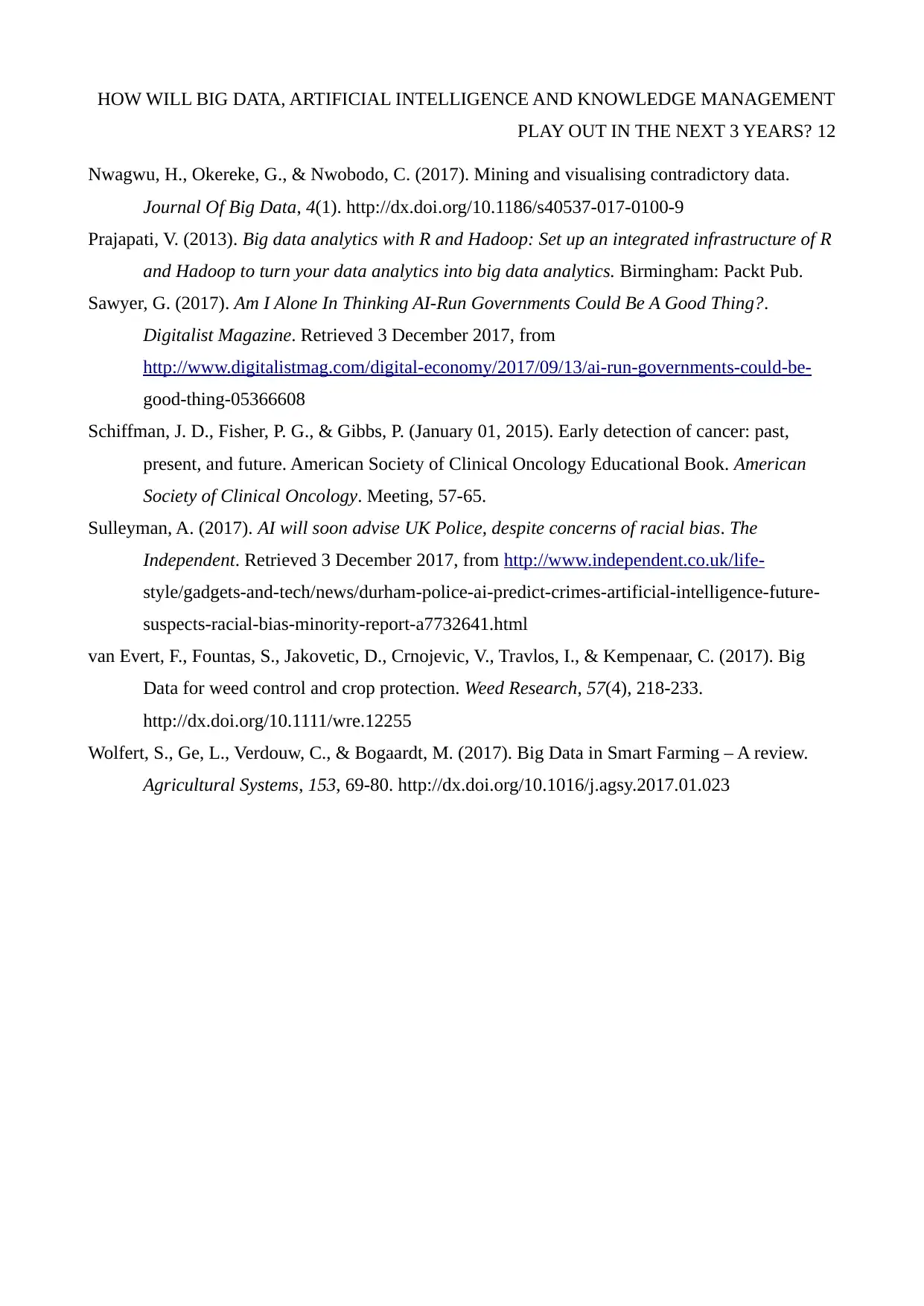
HOW WILL BIG DATA, ARTIFICIAL INTELLIGENCE AND KNOWLEDGE MANAGEMENT
PLAY OUT IN THE NEXT 3 YEARS? 12
Nwagwu, H., Okereke, G., & Nwobodo, C. (2017). Mining and visualising contradictory data.
Journal Of Big Data, 4(1). http://dx.doi.org/10.1186/s40537-017-0100-9
Prajapati, V. (2013). Big data analytics with R and Hadoop: Set up an integrated infrastructure of R
and Hadoop to turn your data analytics into big data analytics. Birmingham: Packt Pub.
Sawyer, G. (2017). Am I Alone In Thinking AI-Run Governments Could Be A Good Thing?.
Digitalist Magazine. Retrieved 3 December 2017, from
http://www.digitalistmag.com/digital-economy/2017/09/13/ai-run-governments-could-be-
good-thing-05366608
Schiffman, J. D., Fisher, P. G., & Gibbs, P. (January 01, 2015). Early detection of cancer: past,
present, and future. American Society of Clinical Oncology Educational Book. American
Society of Clinical Oncology. Meeting, 57-65.
Sulleyman, A. (2017). AI will soon advise UK Police, despite concerns of racial bias. The
Independent. Retrieved 3 December 2017, from http://www.independent.co.uk/life-
style/gadgets-and-tech/news/durham-police-ai-predict-crimes-artificial-intelligence-future-
suspects-racial-bias-minority-report-a7732641.html
van Evert, F., Fountas, S., Jakovetic, D., Crnojevic, V., Travlos, I., & Kempenaar, C. (2017). Big
Data for weed control and crop protection. Weed Research, 57(4), 218-233.
http://dx.doi.org/10.1111/wre.12255
Wolfert, S., Ge, L., Verdouw, C., & Bogaardt, M. (2017). Big Data in Smart Farming – A review.
Agricultural Systems, 153, 69-80. http://dx.doi.org/10.1016/j.agsy.2017.01.023
PLAY OUT IN THE NEXT 3 YEARS? 12
Nwagwu, H., Okereke, G., & Nwobodo, C. (2017). Mining and visualising contradictory data.
Journal Of Big Data, 4(1). http://dx.doi.org/10.1186/s40537-017-0100-9
Prajapati, V. (2013). Big data analytics with R and Hadoop: Set up an integrated infrastructure of R
and Hadoop to turn your data analytics into big data analytics. Birmingham: Packt Pub.
Sawyer, G. (2017). Am I Alone In Thinking AI-Run Governments Could Be A Good Thing?.
Digitalist Magazine. Retrieved 3 December 2017, from
http://www.digitalistmag.com/digital-economy/2017/09/13/ai-run-governments-could-be-
good-thing-05366608
Schiffman, J. D., Fisher, P. G., & Gibbs, P. (January 01, 2015). Early detection of cancer: past,
present, and future. American Society of Clinical Oncology Educational Book. American
Society of Clinical Oncology. Meeting, 57-65.
Sulleyman, A. (2017). AI will soon advise UK Police, despite concerns of racial bias. The
Independent. Retrieved 3 December 2017, from http://www.independent.co.uk/life-
style/gadgets-and-tech/news/durham-police-ai-predict-crimes-artificial-intelligence-future-
suspects-racial-bias-minority-report-a7732641.html
van Evert, F., Fountas, S., Jakovetic, D., Crnojevic, V., Travlos, I., & Kempenaar, C. (2017). Big
Data for weed control and crop protection. Weed Research, 57(4), 218-233.
http://dx.doi.org/10.1111/wre.12255
Wolfert, S., Ge, L., Verdouw, C., & Bogaardt, M. (2017). Big Data in Smart Farming – A review.
Agricultural Systems, 153, 69-80. http://dx.doi.org/10.1016/j.agsy.2017.01.023
1 out of 12
Related Documents
Your All-in-One AI-Powered Toolkit for Academic Success.
+13062052269
info@desklib.com
Available 24*7 on WhatsApp / Email
![[object Object]](/_next/static/media/star-bottom.7253800d.svg)
Unlock your academic potential
© 2024 | Zucol Services PVT LTD | All rights reserved.




